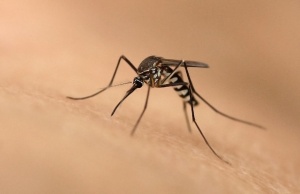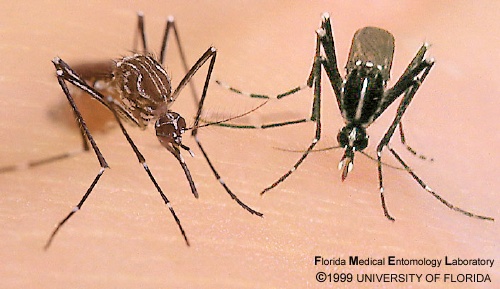Chikungunya Fever: Difference between revisions
No edit summary |
No edit summary |
||
| Line 24: | Line 24: | ||
*There has been increased prevalence in densely populated, urbanized areas, since humans are the only reservoir of the virus. | *There has been increased prevalence in densely populated, urbanized areas, since humans are the only reservoir of the virus. | ||
*Poor living conditions and maintenance of peridomestic environment including pooling of water in water recipients or tyres and inappropriate waste disposal.These are all sources of Aedes mosquito species.<ref name="Sissoko">Sissoko D, Moendandze A, Malvy D, Giry C, Ezzedine K, Solet J et al. Seroprevalence and Risk Factors of Chikungunya Virus Infection in Mayotte, Indian Ocean, 2005-2006: A Population-Based Survey. PLoS ONE. 2008;3(8):e3066.</ref> | *Poor living conditions and maintenance of peridomestic environment including pooling of water in water recipients or tyres and inappropriate waste disposal.These are all sources of Aedes mosquito species.<ref name="Sissoko">Sissoko D, Moendandze A, Malvy D, Giry C, Ezzedine K, Solet J et al. Seroprevalence and Risk Factors of Chikungunya Virus Infection in Mayotte, Indian Ocean, 2005-2006: A Population-Based Survey. PLoS ONE. 2008;3(8):e3066.</ref> | ||
*Migration and Travelling; the CDC estimated approximately 9 million people travel between the United States and the Caribbean each year, increasing the risk of transmission <ref name="cdc" /><br> | *Migration and Travelling; the CDC estimated approximately 9 million people travel between the United States and the Caribbean each year, increasing the risk of transmission <ref name="cdc" /> | ||
= Clinical Features <ref name="Staples et al" /> = | |||
*The incubation period for Chikunguyna fever is noted to be between 3-7 days starting with fevers greater than 38.9°C which can last up to 2 weeks and are biphasic in nature | |||
*Following the fever, majority of infected people develop severe polyarthralgias which are usually symmetric | |||
*Pains are most commonly in the wrists, elbows, fingers, knees and ankles but are not limited to these. | |||
*Pain and Joint swelling are often incapacitating and result in severe disabilities which can last for months. | |||
*The development of a maculopapular rash is often associated | |||
*Additionally, the individual may experience cervical lymphadenopathy, headaches, fatigue, nausea, vomiting, conjunctivitis and myalgia.<ref name="Rhule">Rhule V. Chikungunya. Presentation presented at; 2015; Utica, New York and Kingston,Jamaica.</ref> | |||
*In the acute stage of infection, blood tests may reveal abnormalities such as leukopenia, thrombocytopenia, hypocalcemia and moderate increase in liver function test results | |||
*Asymptomatic cases have also been reported | |||
==== Musculoskeletal Implications ==== | |||
*In the chronic phase of the infection, individuals may experience musculoskeletal symptoms for several weeks to months | |||
*Joint manifestations such as joint effusions, hygromas, bursitis and axial pain can be identified in areas with previously occurring injuries | |||
*Carpal Tunnel syndrome and Raynaud phenomenon in chronic phase have been noted <ref name="Parola">Parola P, Simon F, Oliver M. Tenosynovitis and Vascular Disorders Associated with Chikungunya Virus-Related Rheumatism. Clinical Infectious Diseases. 2007;45(6):801-802.</ref> | |||
*Carpal or Cubital Tunnel syndromes are often a result of hypertrophic tenosynovitis of the anterior wrist <ref name="Parola" /> | |||
==== Other Complications<ref name="Obe">Obeyesekere I, Hermon Y. Myocarditis and cardiomyopathy after arbovirus infections (dengue and chikungunya fever). Heart. 1972;34(8):821-827.</ref> ==== | |||
*Cardiac complications were also reported in a number persons infected with the chikunguyna virus resulting in cases of myocarditis and cardiomyopathy. In many cases, these conditions have been noted to resolve spontaneously | |||
*Chikungunya fever is rarely fatal however there are cases of death has been reported resulting from severe complications or by a weakened immune system | |||
<br><br><br> | |||
== Recent Related Research (from [http://www.ncbi.nlm.nih.gov/pubmed/ Pubmed]) == | == Recent Related Research (from [http://www.ncbi.nlm.nih.gov/pubmed/ Pubmed]) == | ||
Revision as of 21:45, 1 July 2015
Original Editor - Your name will be added here if you created the original content for this page.
Top Contributors - Vanessa Rhule, Lucinda hampton, Evan Thomas, Rishika Babburu, WikiSysop and Kim Jackson
Chikungunya (CHIK-V) Fever
[edit | edit source]
- An acute febrile illness associated with polyarthralgias, caused by the infection of the arthropod-borne alpha-virus, Chikunguyna virus (CHIK-V).
- The virus is transmitted to humans primarily through the bite of an infected mosquito
- The term Chikungunya is derived from the Makinde word meaning “that which bends up” [1]
- The first discovery of the CHIK-V was in 1952 in Tanzania, Africa with the first outbreak noted in 1999 in Malaysia affecting 27 people [2].
- The virus re-emerged in 2004 in countries of the Indian Ocean and has since then, spread to new locations leading to millions of cases throughout countries globally.
Aetiology[edit | edit source]
- The Aedes Aegypti and Aedes Albopictus mosquitos are the main vectors of the virus.
- The human being becomes the reservoir of infection and transmitted from human to human via the infected mosquito.
- These mosquitos bite mainly in the daytime and are also known to transmit the dengue virus [3]
Risk Factors
[edit | edit source]
- There has been increased prevalence in densely populated, urbanized areas, since humans are the only reservoir of the virus.
- Poor living conditions and maintenance of peridomestic environment including pooling of water in water recipients or tyres and inappropriate waste disposal.These are all sources of Aedes mosquito species.[4]
- Migration and Travelling; the CDC estimated approximately 9 million people travel between the United States and the Caribbean each year, increasing the risk of transmission [3]
Clinical Features [1][edit | edit source]
- The incubation period for Chikunguyna fever is noted to be between 3-7 days starting with fevers greater than 38.9°C which can last up to 2 weeks and are biphasic in nature
- Following the fever, majority of infected people develop severe polyarthralgias which are usually symmetric
- Pains are most commonly in the wrists, elbows, fingers, knees and ankles but are not limited to these.
- Pain and Joint swelling are often incapacitating and result in severe disabilities which can last for months.
- The development of a maculopapular rash is often associated
- Additionally, the individual may experience cervical lymphadenopathy, headaches, fatigue, nausea, vomiting, conjunctivitis and myalgia.[5]
- In the acute stage of infection, blood tests may reveal abnormalities such as leukopenia, thrombocytopenia, hypocalcemia and moderate increase in liver function test results
- Asymptomatic cases have also been reported
Musculoskeletal Implications [edit | edit source]
- In the chronic phase of the infection, individuals may experience musculoskeletal symptoms for several weeks to months
- Joint manifestations such as joint effusions, hygromas, bursitis and axial pain can be identified in areas with previously occurring injuries
- Carpal Tunnel syndrome and Raynaud phenomenon in chronic phase have been noted [6]
- Carpal or Cubital Tunnel syndromes are often a result of hypertrophic tenosynovitis of the anterior wrist [6]
Other Complications[7][edit | edit source]
- Cardiac complications were also reported in a number persons infected with the chikunguyna virus resulting in cases of myocarditis and cardiomyopathy. In many cases, these conditions have been noted to resolve spontaneously
- Chikungunya fever is rarely fatal however there are cases of death has been reported resulting from severe complications or by a weakened immune system
Recent Related Research (from Pubmed)[edit | edit source]
Extension:RSS -- Error: Not a valid URL: Feed goes here!!|charset=UTF-8|short|max=10
References[edit | edit source]
References will automatically be added here, see adding references tutorial.
- ↑ 1.0 1.1 Staples J, Breiman R, Powers A. Chikungunya Fever: An Epidemiological Review of a Re‐Emerging Infectious Disease. Clinical Infectious Diseases. 2009;49(6):942-948.
- ↑ Selvaraj I. Chikungunya. Presentation presented at; New Delhi.
- ↑ 3.0 3.1 Cdc.gov. Chikungunya outbreak progresses in Caribbean, Central and South America| CDC Online Newsroom | CDC [Internet]. 2015 [cited 20 June 2015]. Available from: http://www.cdc.gov/media/releases/2014/p1106-chikungunya-outbreak.html
- ↑ Sissoko D, Moendandze A, Malvy D, Giry C, Ezzedine K, Solet J et al. Seroprevalence and Risk Factors of Chikungunya Virus Infection in Mayotte, Indian Ocean, 2005-2006: A Population-Based Survey. PLoS ONE. 2008;3(8):e3066.
- ↑ Rhule V. Chikungunya. Presentation presented at; 2015; Utica, New York and Kingston,Jamaica.
- ↑ 6.0 6.1 Parola P, Simon F, Oliver M. Tenosynovitis and Vascular Disorders Associated with Chikungunya Virus-Related Rheumatism. Clinical Infectious Diseases. 2007;45(6):801-802.
- ↑ Obeyesekere I, Hermon Y. Myocarditis and cardiomyopathy after arbovirus infections (dengue and chikungunya fever). Heart. 1972;34(8):821-827.








